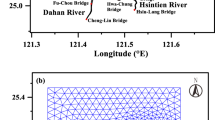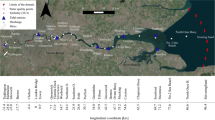Abstract
A three-dimensional contaminant transport model of heavy metal (copper) was coupled with the hydrodynamics and suspended sediment transport module to simulate the transport and distribution of heavy metal (copper) of the Danshui River estuarine system in northern Taiwan. The coupled model was validated with observational data including the water level, tidal current, salinity, suspended sediment concentration, and copper concentration. The model simulation results quantitatively reproduce the measurements. Furthermore, the validated model was employed to explore the influences of the freshwater discharge and suspended sediment on the distribution of copper concentrations in the tidal estuarine system. The results demonstrate that a high freshwater discharge results in a decreasing copper concentration, while a low freshwater discharge raises the copper concentration along the estuarine system. If the suspended sediment transport module was excluded in the model simulations, the predicted copper concentration underestimated the measured data. The distribution of copper concentrations without the suspended sediment transport module was lower than that with the suspended sediment transport module. The simulated results indicate that the freshwater discharge and suspended sediment play crucial roles in affecting the distribution of copper concentrations in the tidal estuarine system.









Similar content being viewed by others
References
Alvarez, A. M., & Trento, A. E. (2014). Analytical and numerical solutions for sediment and heavy metal transport: a 1D simplified case. Water Quality Research Journal, 49(3), 258–272.
Benoit, G., Oktay-Marshall, S. D., Cantu, A., Hood, E. M., Cokeman, C. H., Corapcioglu, M. O., & Santschi, P. H. (1994). Partitioning of Cu, Pb, Ag, Zn, Fe, Al, and Mn between filter-retained particles, colloids, and solution in six Texas estuaries. Marine Chemistry, 45(4), 307–336.
Blumberg, A. F., & Mellor, G. L. (1987). A description of a three-dimensional coastal ocean circulation model. In N. Heaps (Ed.), Three-dimensional coastal ocean models, Coastal and Estuarine Studies (Vol. 4, pp. 1–16). Washington, DC: AGU.
Casulli, V., & Cheng, R. T. (1992). Semi-implicit finite difference methods for three-dimensional shallow water flow. International Journal for Numerical Methods in Fluids, 15(6), 629–648.
Casulli, V., & Walters, R. A. (2000). An unstructured grid, three-dimensional model based on the shallow water equations. International Journal for Numerical Methods in Fluids, 32(3), 331–348.
Chen, W. B., & Liu, W. C. (2017). Investigating the fate and transport of fecal coliform contamination in a tidal estuarine system using a three-dimensional model. Marine Pollution Bulletin, 116, 366–384.
Chen, C., Liu, H., & Beardsley, R. C. (2003). An unstructured grid, finite-volume, three-dimensional primitive equations ocean model: application to coastal ocean and estuaries. Journal of Atmospheric and Oceanic Technology, 20, 159–186.
Chen, W. B., Liu, W. C., Kimura, N., & Hsu, M. H. (2010). Particle release transport in Danshui River estuarine system and adjacent coastal ocean: a modeling assessment. Environmental Monitoring and Assessment, 168(1–4), 407–428.
Chen, W. B., Liu, W. C., & Hsu, M. H. (2011). Water quality modeling in a tidal estuarine system using a three-dimensional model. Environmental Engineering Science, 28(6), 443–459.
Cho, E., Arhonditsis, G. B., Khim, J., Chung, S., & Heo, T. Y. (2016). Modeling metal-sediment interaction process: parameter sensitivity assessment and uncertainty analysis. Environmental Modelling & Software, 80, 159–174.
Das, A., Justic, D., Inoue, M., Hoda, A., Huang, H., & Park, D. (2012). Impacts of Mississippi River diversions on salinity gradients in a deltaic Louisiana estuary: ecological and management implications. Estuarine, Coastal and Shelf Science, 111, 17–26.
de Souza Machado, A. A., Spencer, K., Kloas, W., Toffolon, M., & Zarfl, C. (2016). Metal fate and effects in estuaries: a review and conceptual model for better understanding of toxicity. Science of the Total Environment, 541, 268–281.
Etemad-Shahidi, A., Shahkolahi, A., & Liu, W. C. (2010). Modeling of hydrodynamics and cohesive sediment processes in an estuarine system: case study in Danshui River. Environmental Modeling and Assessment, 15(4), 261–271.
Hartnett, M., & Berry, A. (2012). Numerical modelling of the transport and transformation of trace metals in a highly dynamic estuarine environment. Advances in Engineering Software, 44(1), 170–179.
Hartnett, M., Lin, B., Jones, P. D., & Berry, A. (2006). Modelling the fate and transport of nickel in the Mersey Estuary. Journal of Environmental Science and Health, Part A, 41(5), 825–847.
He, M., Wang, Z., & Tang, H. (2010). Modeling the ecological impacts of heavy metals on aquatic ecosystems: a framework for the development of an ecological model. Science of the Total Environment, 266(1–3), 291–298.
Horvat, Z., & Horvat, M. (2016). Two-dimensional heavy metal transport model for natural watercourses. River Research and Applications, 32(6), 1327–1341.
Hsu, M. H., Kuo, A. Y., Kuo, J. T., & Liu, W. C. (1999). Procedures to calibrate and verify numerical models of estuarine hydrodynamics. Journal of Hydraulic Engineering, 125(2), 166–182.
Huang, K. M., & Lin, S. (2003). Consequences and implication of heavy metal spatial variations in sediments of the Keelung River drainage basin, Taiwan. Chemosphere, 53(9), 1113–1121.
Ji, G., Hamrick, J. H., & Pagenkopf, J. (2002). Sediment and metal modeling in shallow river. Journal of Environmental Engineering, 128(2), 105–119.
Jiann, K. T., Wen, L. S., & Santschi, P. H. (2005). Trace metal (Cd, Cu, Ni and Pb) partitioning, affinities and removal in the Danshuei River estuary, a micro-tidal, temporally anoxic estuary in Taiwan. Marine Chemistry, 96(3), 293–313.
Karna, T., Baptista, A. M., Lopez, J. E., Turner, P. J., McNeil, C., & Sanford, T. B. (2015). Numerical modeling of circulation in high-energy estuaries: a Columbia River estuary benchmark. Ocean Modelling, 88, 54–71.
Lin, H. J., Shao, K. T., Jan, R. Q., Hsieh, H. L., Chen, C. P., Hsieh, L. Y., & Hsiao, Y. T. (2007). A trophic model for the Danshuei River Estuary, a hypoxic estuary in northern Taiwan. Marine Pollution Bulletin, 54(11), 1789–1800.
Liu, W. C., & Chan, W. T. (2014). Assessing the influence of nutrient reduction on water quality using a three-dimensional model: case study in a tidal estuarine system. Environmental Monitoring and Assessment, 186(12), 8807–8825.
Liu, W. C., & Huang, W. C. (2012). Modeling the transport and distribution of fecal coliform in a tidal estuary. Science of the Total Environment, 431, 1–8.
Liu, W. C., Chen, W. B., Cheng, R. T., Hsu, M. H., & Kuo, A. Y. (2007a). Modeling the influence of river discharge on salt intrusion and residual circulation in Danshui River estuary. Continental Shelf Research, 27(7), 900–921.
Liu, K. K., Kuo, S. J., Wen, L. S., & Chen, K. L. (2007b). Carbon and nitrogen isotopic composition of particulate organic matter and biogeochemical processes in the eutrophic Danshuei Estuary in northern Taiwan. Science of the Total Environment, 382, 103–120.
Liu, W. C., Chen, W. B., Kuo, J. T., & Wu, C. (2008). Numerical determination of residence time and age in a partially mixed estuary using three-dimensional hydrodynamic model. Continental Shelf Research, 28(8), 1068–1088.
Lu, S., Li, R., Xia, X., & Zheng, J. (2014). Use of a three-dimensional model to predict heavy metal (copper) fluxes in the Qujiang estuary. Water Science and Technology, 69(6), 1334–1343.
Menon, M. G., Gibbs, R. J., & Phillips, A. (1998). Accumulation of muds and metals in the Hudson River estuary turbidity maximum. Environmental Geology, 34(2–3), 214–222.
Murdoch, N., Jones, P. J. C., Falconer, R. A., & Lin, B. (2010). A modelling assessment of contaminant distributions in the Severn Estuary. Marine Pollution Bulletin, 61(1–3), 124–131.
Ng, B., Turner, A., Tyler, A. O., Falconer, R. A., & Millward, G. E. (1996). Modelling contaminant geochemistry in estuaries. Water Research, 30(1), 63–74.
Partheniades, E. (1965). Erosion and deposition of cohesive soils. Journal of the Hydraulics Division, 91(1), 105–139.
Premier, V., de Souza Machado, A. A., Mitchell, S., Zarfl, C., Spencer, K., & Toffolon, M. (2019). A model-based analysis of metal fate in the Thames Estuary. Estuaries and Coasts, 42(4), 1185–1201.
Rodi, W. (1984). Turbulence models and their applications in hydraulics: a state of the art review. Delft: International Association for Hydraulics Research.
Samano, M. L., Garcia, A., Revilla, J. A., & Alvarez, C. (2014). Modeling heavy metal concentration distributions in estuarine waters: an application to Suances Estuary (Northern Spain). Environmental Earth Sciences, 72(8), 2931–2945.
Shchepetkin, A. F., & McWilliams, J. C. (2005). The regional oceanic modeling system (ROMS): a split-explicit, free-surface, topography-following-coordinate, oceanic model. Ocean Modelling, 9(4), 347–404.
Shrestha, O. L., & Orlob, G. T. (1996). Multiphase distribution of cohesive sediments and heavy metals in estuarine systems. Journal of Environmental Engineering, 122(8), 730–740.
Song, Y., & Haidvogel, D. (1994). A semi-implicit ocean circulation model using a generalized topography-following coordinate system. Journal of Computational Physics, 115(1), 228–244.
Trento, A. E., & Alvarez, A. M. (2011). A numerical model for the transport of chromium and fine sediments. Environmental Modeling and Assessment, 16(6), 551–564.
Wang, C. F., Hsu, M. H., & Kuo, A. Y. (2004). Residence time of the Danshuei River estuary, Taiwan. Estuarine, Coastal and Shelf Science, 60(3), 381–393.
Wang, C. F., Hsu, M. H., Liu, W. C., Hwang, J. S., Wu, J. T., & Kuo, A. Y. (2007). Simulation of water quality and plankton dynamics in the Danshuei River estuary. Journal of Environmental Science and Health, Part A, 42(7), 933–953.
Wang, C., Wang, X., Wang, B., Zhang, C., Shi, Z., & Zhu, C. (2009). Level and fate of heavy metals in the Changjiang estuary and its adjacent waters. Oceanology, 49(1), 64–72.
Warner, C. J., Geyer, W. R., & Lerczak, J. A. (2005). Numerical modeling of an estuary: a comprehensive skill assessment. Journal of Geophysical Research, 110, C05001.
Water Resources Agency. (2017). Hydrological year book of Taiwan. Nantun District: Water Resources Agency, Ministry of Economic Affairs.
Wen, L. S., Jiann, K. T., & Liu, K. K. (2008). Seasonal variation and flux of dissolved nutrients in the Danshuei Estuary, Taiwan: a hypoxic subtropical mountain river. Estuarine, Coastal and Shelf Science, 78(4), 694–704.
Willmott, C. J. (1981). On the validation of models. Physical Geography, 2(2), 184–194.
Woitke, P., Wellmitz, J., Helm, D., Kube, P., Lepom, P., & Litheraty, P. (2003). Analysis and assessment of heavy metal pollution in suspended soils and sediments of the river Danube. Chemosphere, 51(8), 633–642.
Wu, Y., Falconer, R. A., & Lin, B. (2005). Modelling trace metal concentration distributions in estuarine waters. Estuarine, Coastal and Shelf Science, 64(4), 699–709.
Zhang, Y., & Baptista, A. M. (2008). SELFE: A semi-implicit Eulerian-Lagrangian finite-element model for cross-scale ocean circulation. Ocean Modelling, 21(3–4), 71–96.
Zhang, Y., Baptista, A. M., & Myers, E. P. (2004). A cross-scale model for 3D baroclinic circulation in estuary-plume-shelf systems: I. Formulation and skill assessment. Continental Shelf Research, 24(18), 2187–2214.
Zhang, W., Feng, H., Zheng, J., Hoitink, A. J. F., van der Vegt, M., Zhu, Y., & Cai, H. (2013). Numerical simulation and analysis of saltwater intrusion lengths in Pearl River Delta, China. Journal of Coastal Research, 29(2), 372–382.
Acknowledgements
The authors want to express their sincere appreciation to the Taiwan Water Resources Agency and the Taiwan Environmental Protection Administration for kindly providing the measured data. The authors also thank Dr. Wei-Bo Chen of the National Science and Technology Center for Disaster Reduction for sharing the suspended sediment and heavy metal transport model. Two anonymous reviewers are thanked for their constructive comments to substantially improve the paper.
Funding
This study was partially supported by funding from the Ministry of Science and Technology, Taiwan, under grant number 107-2625-M-239-002.
Author information
Authors and Affiliations
Corresponding author
Additional information
Publisher’s note
Springer Nature remains neutral with regard to jurisdictional claims in published maps and institutional affiliations.
Electronic supplementary material
ESM 1
(DOCX 1496 kb)
Rights and permissions
About this article
Cite this article
Liu, WC., Liu, HM. & Ken, PJ. Investigating the contaminant transport of heavy metals in estuarine waters. Environ Monit Assess 192, 31 (2020). https://doi.org/10.1007/s10661-019-8012-0
Received:
Accepted:
Published:
DOI: https://doi.org/10.1007/s10661-019-8012-0




